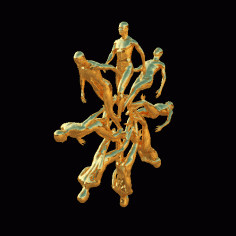vince mckelvie
gif

source: ww2kqedorg
Vince McKelvie makes sculptural gifs and software environments that crack open the well of kinetic sculpture. His pieces explore texture, shape and movement with digital rendering software influencing what is possible, as the material stuff (marble or found objects) of traditional sculpture. His gifs pair glossy digital textures with shapes that dissolve and remake themselves in infinite loops, visually recycling themselves as the form morphs.
In an interview with Giphy, the search engine just for gifs, McKelvie revealed the two-fold reason behind the explosion of gif art online “GIFs are the Polaroids of animation, they’re instant gratification.” Gifs reach audiences because they are animated without pressing play. They have the visual interest of moving images with the ease and immediacy of stills. That covers how audiences interact with the work, but there is another crucial reason for the rise of gifs.
In the interview McKelvie continued, “It’s… important to me to be able to display my images in a dynamic context which would be difficult with other media.” Online it’s all about making work that is flexible, that can go where the eyes are. Unlike video, the previous home of animation online, which is trapped inside a video player, gifs are free to roam the web (unless we include Facebook, of course, a long hold-out in the widespread use of gifs online). Anywhere a still image is shown online, gifs are likely also compatible. Artists whose work is either exclusively or even just primarily made to be seen online have learned to create work that seamlessly transitions not just from browser to browser, each with their peculiar differences, but also between personal websites, Twitter feeds, Tumblr, DeviantArt, a whole variety of art collection sites and ultimately even inside other projects.
Because McKelvie also makes software-driven work, including the browser-wide environments on his homepage as well as 3dGif, a new WebGL-based website that allows the viewer to use any online image or gif, both — unlike video — easily compatible with this kind of in-browser application, to reskin a morphing 3D shape and the box it hovers inside. WebGL, which was initially released in 2011, is an API (application programming interface) that allows users to render dynamic 3D scenes in the browser, no plug-ins required, and is quickly becoming another popular tool in the net artist grab bag.
Not only is the work itself made abundant, an essentially infinite quantity of perfect duplicates, but McKelvie releases his working files as well. “All my 3D files, .movs, and image sequences are free to download, which creates another potential context for my gifs.” The files are both an educational resource for other artists interested in aping McKelvie’s technique, but also encourage the recycling and reuse of his work in other projects, further maximizing exposure.
McKelvie is the quintessential Internet artist, creating projects that are from, of and about the Internet. The work and the way he creates, releases and talks about it are shaped by and tailored to success in the Internet’s attention economy.
.
.
.
.
.
.
.
source: cartoonbrew
The undulating, reflective objects are hard to stop staring at. Vince creates so many that he has been able to explore variations on themes in the forms and materials of his imaginary creations.

